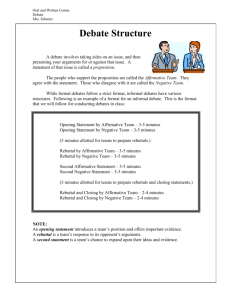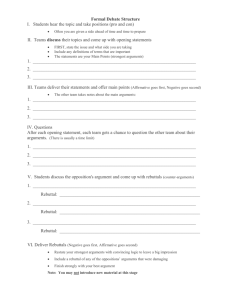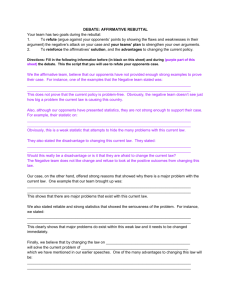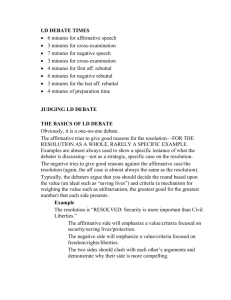Debate Overview (with thanks given to Mrs. Middelthon for her
advertisement
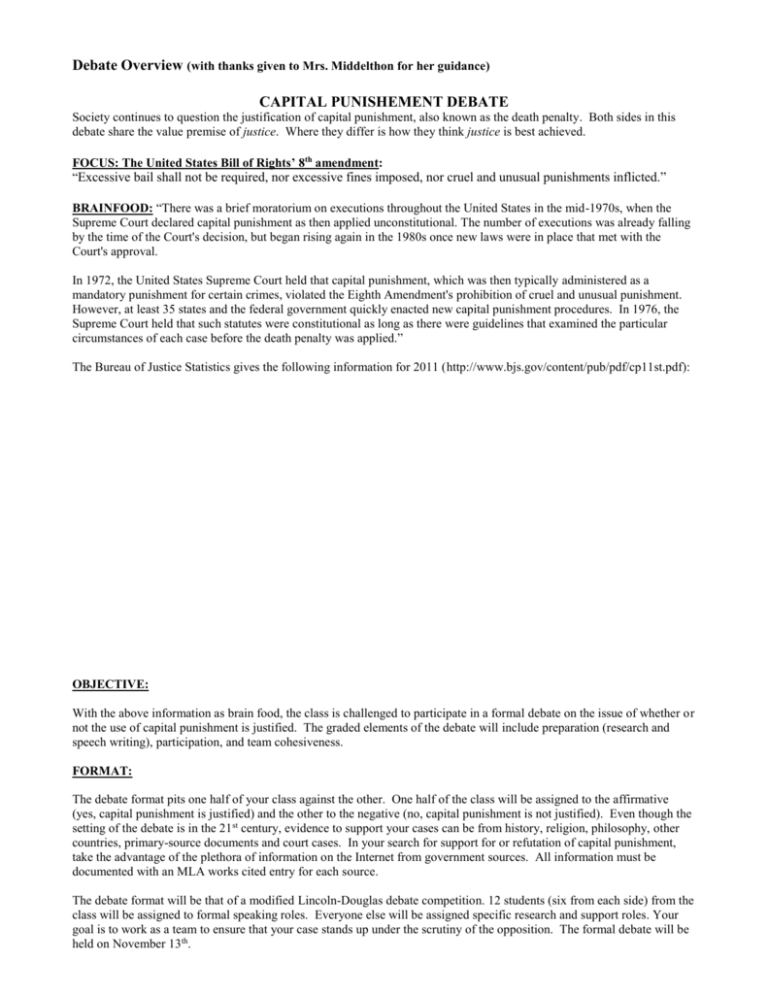
Debate Overview (with thanks given to Mrs. Middelthon for her guidance) CAPITAL PUNISHEMENT DEBATE Society continues to question the justification of capital punishment, also known as the death penalty. Both sides in this debate share the value premise of justice. Where they differ is how they think justice is best achieved. FOCUS: The United States Bill of Rights’ 8th amendment: “Excessive bail shall not be required, nor excessive fines imposed, nor cruel and unusual punishments inflicted.” BRAINFOOD: “There was a brief moratorium on executions throughout the United States in the mid-1970s, when the Supreme Court declared capital punishment as then applied unconstitutional. The number of executions was already falling by the time of the Court's decision, but began rising again in the 1980s once new laws were in place that met with the Court's approval. In 1972, the United States Supreme Court held that capital punishment, which was then typically administered as a mandatory punishment for certain crimes, violated the Eighth Amendment's prohibition of cruel and unusual punishment. However, at least 35 states and the federal government quickly enacted new capital punishment procedures. In 1976, the Supreme Court held that such statutes were constitutional as long as there were guidelines that examined the particular circumstances of each case before the death penalty was applied.” The Bureau of Justice Statistics gives the following information for 2011 (http://www.bjs.gov/content/pub/pdf/cp11st.pdf): OBJECTIVE: With the above information as brain food, the class is challenged to participate in a formal debate on the issue of whether or not the use of capital punishment is justified. The graded elements of the debate will include preparation (research and speech writing), participation, and team cohesiveness. FORMAT: The debate format pits one half of your class against the other. One half of the class will be assigned to the affirmative (yes, capital punishment is justified) and the other to the negative (no, capital punishment is not justified). Even though the setting of the debate is in the 21st century, evidence to support your cases can be from history, religion, philosophy, other countries, primary-source documents and court cases. In your search for support for or refutation of capital punishment, take the advantage of the plethora of information on the Internet from government sources. All information must be documented with an MLA works cited entry for each source. The debate format will be that of a modified Lincoln-Douglas debate competition. 12 students (six from each side) from the class will be assigned to formal speaking roles. Everyone else will be assigned specific research and support roles. Your goal is to work as a team to ensure that your case stands up under the scrutiny of the opposition. The formal debate will be held on November 13th. The debate will run as follows: First Affirmative Speech Speaking time 6 minutes First Negative Cross-Examination 3 minutes First Negative Speech 6 minutes First Affirmative Cross-Examination 3 minutes Second Affirmative Speech 6 minutes Second Negative Cross-Examination 2 minutes Second Negative Speech 6 minutes Second Affirmative Cross Examination 2 minutes First Negative Rebuttal 4 minutes First Affirmative Rebuttal 4 minutes Second Negative Rebuttal 4 minutes Second Affirmative Rebuttal 4 minutes > 1 minute prep time > 2 minutes prep time > 1 minute prep time > 2 minutes prep time > 1 minute prep time > 2 minutes prep time > 1 minute prep time > 2 minutes prep time > 2 minutes prep time > 2 minutes prep time > 2 minutes prep time Note that all formal speakers will be timed and expected to remain within the time limits. If you go over time, that time will be deducted from the next speaker for your section. Assignment Descriptions: First Affirmative Speech: Your job is to set forth your side’s case in as much detail and clarity as possible. Your speech should be polished and above all, well-organized and well-supported by evidence. You have the advantage of setting the terms of the debate. First Negative Cross-Ex: Your job is to question the first affirmative speaker in order to (1) clarify the affirmative arguments and (2) raise doubts about the affirmative side’s reasoning and evidence. Remember that your first speaker is getting ready to speak, so coordinate with them to make sure you don’t take too much wind out of their sails. First Negative Speech: Your job will be to poke holes all through the first affirmative’s case by challenging it on the basis of reasoning and soundness of evidence. You will want to have some solid evidence of your own to counter the affirmative arguments and to support your own arguments that capital punishment is not justified. Your reasoning that capital punishment is not justified should make up about two-thirds of your case, and the other one-third should refute the affirmative argument. First Affirmative Cross-Ex: Like your negative counterpart, your job is to clarify and challenge reasoning and evidence, through cross-ex of the first negative speaker. Second Affirmative Speech: Your job is to narrow down the arguments of the first negative speaker and, if time, build upon the first affirmative’s case. This is often considered the most difficult position, because it requires a lot of improvisation. Nevertheless, you should have cases prepared in advance both to refute negative arguments and bolster your own. No new evidence can be presented in rebuttals, so you will need to get everything in to support your side that you can. Second Negative Cross-Ex: Same as your colleagues, but also to clarify where the affirmative speaker may have missed responding to an argument presented by the first negative speech. Your side can exploit this kind of mistake to its advantage. Second Negative Speech: Your job is to exploit the weakest points in the affirmative case by building on the first negative’s arguments, refuting the second affirmatives and adding more negative arguments of your own. Also, point out where the second affirmative failed to respond to your first negative arguments. That’s a lot to do, but remember that no new evidence can be introduced in rebuttals. You’ll need crisp, clear delivery. Second Affirmative Cross-Ex: Same as your second negative colleague above, except that you’re trying to catch where the second negative speaker may have missed the boat. This position is important because you’re sandwiched in between two negative speakers. Now’s the time to pull out your bombshell questions to try to trip up the negative side. First Negative Rebuttal: Start wrapping up your side’s arguments by pointing out where (1) the affirmative case is weakest, (2) the affirmative side has failed to respond to challenges by your side, and (3) where your case is strongest. Punch up your strong points. First Affirmative Rebuttal: Vice versa for you but your job is a little tougher because you need to pick up where the second affirmative speaker left off, which is seven minutes worth of arguments ago. Second Negative Rebuttal: Counter second affirmative rebuttal and punch up your strong points. You have the last word for your side. No pressure. Second Affirmative Rebuttal: You have the ability to make or break your side’s case by refuting the negative arguments and highlighting your side’s strongest arguments. This slot was made for great orators. You have the final word. Make it count. Researchers: Much like Congressional staffers support their Senator or Representative, your job will be to provide moral, organizational, and drafting of information support for your side's speakers. You will help your speakers develop your side's case; you are expected to work together as a team as you are the organizational linchpin of your side's efforts. On the day of the debate, bring note cards on which you can write ideas/information/reminders to pass quietly to speakers. Research teams are split up into the affirmative and negative side of the debate. Each member of the team of researchers needs to decide what their focus of research will be, ie., history, religion, legislation, legal case studies, philosophy, primary source documentation, other countries, etc. Each researcher is responsible for obtaining sufficient research information for their side’s speakers. You are also responsible during the debate for passing forward relevant information to your speakers during prep time. Speakers will also research and not sit idly by – Remember - you want your side to win the debate and take your opposition to the cleaners. .Preparation: The preparation grade will be based on the following criteria, which are individualized for each type of role. First / Second Affirmative Speech AND First / Second Negative Speech: a typed outline of your speech, including citations of evidence. This text should be two-three pages in length. Note that the evidence for your speech will be provided by research teams. Your main job here is to organize your information and rehearse your speech. You need to team up with your researchers to tell them the type of evidence you are looking for. Work with the other speaker to make sure there isn’t any unplanned overlap. Cross Examiners: Will turn in a list of 10 questions each with possible answers and follow-up questions. You really need to think like the opposition. Create a GoogleDoc to share with the other cross-ex in your team. On that document, create a section with your name where you will write your questions, and your partner will do the same on the same document. Rebuttalists: A typed briefing paper of at least one full page in length that you could use in your speech—although you will need to add to your rebuttal as the debate progresses. No new evidence can be introduced during the rebuttal, so you need to work with your researchers and speakers to see what information will have been presented, and how you can wrap it up. One of you may want to focus on one specific area, and the other on another area. Researchers: A set of 20 notes per person is due in your team’s GoogleDoc . Each note must have a proper source citation after it. You will be expected to match up and work with your speakers to organize evidence and help plug gaps in knowledge through targeted research. Work with your team to assure that research efforts are not duplicated. Researchers, use one GoogleDoc for your side: Make a section with your name for your individual notes. After each note, include the works cited entry for the source in MLA format. NOTE that in all cases, your preparation grade is also dependent on persistent, sustained effort in class. If you complete your written requirements early, you need to help out in some other way, such as gathering more research. The idea here is to complete research and writing for the debate in class as much as possible. 2nd period Speakers Affirmative First AFF Speech First AFF Cross-X Second AFF Speech Second AFF Cross-X First AFF Rebuttal Second AFF Rebuttal Researchers AFF Research Focus: (Religion, History, Philosophy/Moral, Law/Legal Precedent/Court Cases, Case Studies, Other Countries, etc.) Name Researcher Name: Negative First NEG Cross-X First NEG Speech Second NEG Cross-X Second NEG Speech First NEG Rebuttal Second NEG Rebuttal NEG Research Focus: (Religion, History, Philosophy/Moral, Law/Legal Precedent/Court Cases, Case Studies, Other Countries, etc.) Name Researcher Name: PLAN OF ATTACK: To make effective use of our time, the following is a schedule of daily objectives for debate preparation: M Nov 4 Library: Review research methods, assign sides, choose roles. T Nov 5 No School W Nov 6 Library Th Nov 7 Library F Nov 8 Library M Nov 11 No School T Nov 12 In Class with laptops: Set plan of attack, tie up loose ends. W Nov 13 Debate! Business attire required. Th Nov 14 Debate Concludes. Business attire required. Debate Debrief. F Nov 15 APQ
